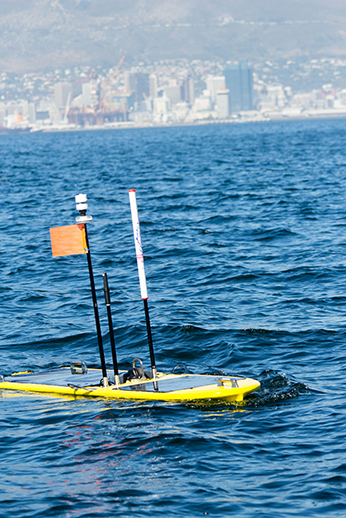Sea-faring glider shows promise for easier, more accurate fish stock level-surveys
Researchers from the CSIR successfully equipped a wave glider with an acoustic echo sounder to detect fish stock levels along the South African coast. The Department of Agriculture, Forestry and Fisheries (DAFF) has the responsibility to determine the available fish stock levels in the Exclusive Economic Zone (EEZ) to regulate and allocate fishing quotas.
Currently, scientists from DAFF conduct these surveys by following a predetermined route along coast. Once the on-board underwater sonar detects species that resemble fish, a net is drawn to capture a sample of the species. Using the two types of data, fishing quotas are then established.
Currently, DAFF only performs two of these surveys per year. Janet Coetzee, a scientist from the department has indicated the need to have technology out on the ocean more often to provide information on fish migration patterns. In an effort to assist DAFF in finding a more cost-effective approach to fishing surveys, the CSIR launched a research project in 2013. The first successful field experiments were already performed in March 2014.
The CSIR’s expertise in oceanography and research in the southern oceans combined with its experience in developing technology for specialist maritime applications, led to the development of a solution that will allow the department to perform many more surveys per year on the one side, and save the department time, money and manpower on the other.
How it came about
The integration of an active sonar system, designed to detect fish and a data-capturing unit onto an unmanned marine vehicle (UMV) that would serve as the sensor platform, was supported by industry partner Sea Technology Services, who provided valuable insights gained from experience in UMV development.
Hannes Zietsman, a senior engineer and maritime defence expert worked with Sea Technology Services to design, develop, and integrate a power supply unit that powers the sonar and data-capturing unit. The UMV relies on wave propulsion to glide forward, making it possible for the vessel to be deployed for months at a time. The data capturing and control unit is housed in a payload compartment made available by Liquid Robotics.
First deployment out in the field
During a field test experiment the system, measuring just under 3 m in length, was deployed for a comprehensive sea trial, which ran for just over two days. Travelling at an average speed of 2.4 km/h the vessel covered 121 km between Robben and Dassen Islands. After examining the data collected it was found that the initial testing had gone well. The signal received from the echo sounder was stable and scientists were able to see schools of fish. There was very little noise, which did not interfere with detecting fish.
Future tests will look at the glider’s performance in rough seas, strong currents, and its ability to cross a vast area in Agulhas Bay and how long it would take to do it. The possibility of deploying swarms of these gliders, fitted with cameras and other devices will enable researchers to identify the specific fish species, which will greatly advance the effectiveness of the surveys. The work will ultimately reduce the amount of ships that have to be out at sea, saving the department’s already strained resources.
The CSIR will continue with the research project, in collaboration with DAFF, in order to create alternative, more cost effective and accurate means of determining the South African fish stock levels. This will include further research into onboard processing of data and the optimisation of the sensor technologies for future application in other maritime related industries. The system will also be able to add value to the maritime surveillance domain.
For more information, please watch the video.
Hannes Zietsman

